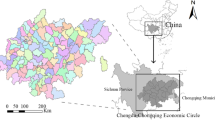Abstract
Resource-dependent cities are cities whose economic development depends on the exploitation and processing of natural resources. Their transformation and sustainable development are an important area of research on regional industrial development, regional economy and urban development. Since the Chinese government launched a pilot project to transform resource-dependent cities, starting with Fuxin in Liaoning Province in 2001, accurately identifying and classifying China’s resource-dependent cities has become a focus of geographical research. Based on previous studies, this paper uses the theory and methods of urban function classification to analyze indicators and threshold values for identifying and classifying resource-dependent cities. It has thus identified 262 cities as being resource-dependent. Looking at the development levels, problems, characteristics and developmental direction of such cities, this paper attempts to establish a comprehensive analytical framework using the two evaluation indicators of resource security and sustainable development. It also creates a model to classify the 262 cities identified as resource-dependent cities into four types: growing cities, mature cities, declining cities and regenerating cities. The different connotations and characteristics of the city types were then analyzed. The results of this research support the delineation of scopes and categories of resource-dependent cities set out in the National Sustainable Development Plan for Resource-Dependent Cities published by the State Council, and they serve as a foundation for formulating policies on planning, classification and guidance.
Similar content being viewed by others
References
Bade F J, Laaser C F, Soltwedel R, 2004. Urban specialization in the internet age: Empirical findings for Germany. Kiel Working Paper, No. 1215.
Duranton G, Puga D, 2001. Nursery cities: Urban diversity, process innovation, and the life cycle of products. American Economic Review, 91(5): 1454–1477.
Duranton G, Puga D, 2003. Micro-foundations of urban agglomeration economies. Social Science Electronic Publishing, 4(4): 2063–2117.
Duranton G, Puga D, 2005. From sectoral to functional urban specialization. Journal of Urban Economics, 57(2): 343–370.
Fan Jie, 1993. A study on the industrial structure transformation of coal-mine cities in China. Acta Geographica Sinica, 48(3): 218–225. (in Chinese)
Fang Chuanglin, Wang Yan, 2015. A comprehensive assessment of urban vulnerability and its spatial differentiation in China. Acta Geographica Sinica, 70(2): 234–247. (in Chinese)
Han Fengqin, Wan Shouqiong, 2014. Classified to promote the sustainable development of resource-based cities in China. Review of Economic Research, (54): 5–11. (in Chinese)
Harris C D, 1943. A functional classification of cities in the United States. Geographical Review, 33(1): 86–99.
Hu Kui, 2001. The basic problems of China’s mining cities. Resources & Industries, 3(5): 1–7. (in Chinese)
Li Wenyan, 1978. Industrial development and urban planning in coal mine cities. Acta Geographica Sinica, 33(1): 63–79. (in Chinese)
Liu Yungang, 2006. The reconsideration of the method to define Chinese resource-based cities. Economic Geography, 26(6): 940–944. (in Chinese)
Liu Yungang, 2009. The functional classification and the characteristics of functional transition of Chinese resource-based cities. Geographical Research, 28(1): 153–160. (in Chinese)
Ma Qingyu, 1986. Development and Layout of Industrial and Mining Cities. Regional Studies on Urban and Industrial Distribution. Bei**g: Science Press. (in Chinese)
Macroeconomic Research Group of National Planning Commission (MRGNPC), 2002. The definition and classification of resource-based cities in China. Macroeconomics, (11): 37–39. (in Chinese)
Nelson H J, 1955. A service classification of American cities. Economic Geography, 31(3): 189–210.
Shen Lei, Cheng **g, 1999. A preliminary discussion on the mechanism of mining cities for sustainable development. Resources Science, 21(1): 44–50. (in Chinese)
Wang Qingyun, 2003. Study on the Economic Transformation of Resource-Based Cities. Bei**g: China Economic Publishing House. (in Chinese)
Wu Chunyou, Ye Ying, 2000. Study of the issue of transformation of the industry for the resource-typed cities. Journal of Dalian University of Technology (Social Sciences), 21(3): 6–9. (in Chinese)
**ao **gsong, Li Hongjun, 2009. A study on definitions and classification of resource-based cities in China. Sino-Global Energy, 14(11): 15–20. (in Chinese)
Yu Jicong, Liu Yuexiang, 2009. Study on the Definition of Mining City and its Sustainable Development Ability. Bei**g: Geological Publishing House. (in Chinese)
Zhang Jianhua, Wang Gaoshang, 2003. Mining dependence and quantitative classification of China mining cities. Resources & Industries, 5(6): 85–89. (in Chinese)
Zhang Wenzhong, Yu Jianhui, Wang Dai et al., 2014. Research on the Sustainable Development of Resource-based Cities in China. Bei**g: Science Press. (in Chinese)
Zhang Yicheng, 1999. The present situation and sustainable development countermeasures of mining cities in China. Journal of China University of Mining and Technology (Social Science), (1): 75–78. (in Chinese)
Zhao Kangjie, Zhao Yujuan, 2011. The definition and classification of resource-based cities: A case study of Shanxi province. China Urban Economy, (30): 40–43. (in Chinese)
Zhao Yukong, 1995. China’s Mining City: Structural Adjustment and Sustainable Development. Changchun: Jilin Science and Technology Press. (in Chinese)
Zhou Changqing, 1994. On the attributes and structures of resources-model cities and their coordinating development. Reform of Economic System, (5): 23–30. (in Chinese)
Zhou Yixing, Roy Bradshaw, 1988. The classification of industrial function of Chinese cities (including attached counties): Theory, method and results. Acta Geographica Sinica, 43(4): 287–298. (in Chinese)
Zhou Yixing, Sun Zexing, 1997. Rediscussion on China’s urban function classification. Geographical Research, 16(1): 11–22. (in Chinese)
Author information
Authors and Affiliations
Corresponding author
Additional information
Foundation: National Natural Science Foundation of China, No. 41671166, No. 41701128
Author: Yu Jianhui (1983-), PhD and Associate Professor, specialized in resource-based cities development studies.
Rights and permissions
About this article
Cite this article
Yu, J., Li, J. & Zhang, W. Identification and classification of resource-based cities in China. J. Geogr. Sci. 29, 1300–1314 (2019). https://doi.org/10.1007/s11442-019-1660-8
Received:
Accepted:
Published:
Issue Date:
DOI: https://doi.org/10.1007/s11442-019-1660-8




